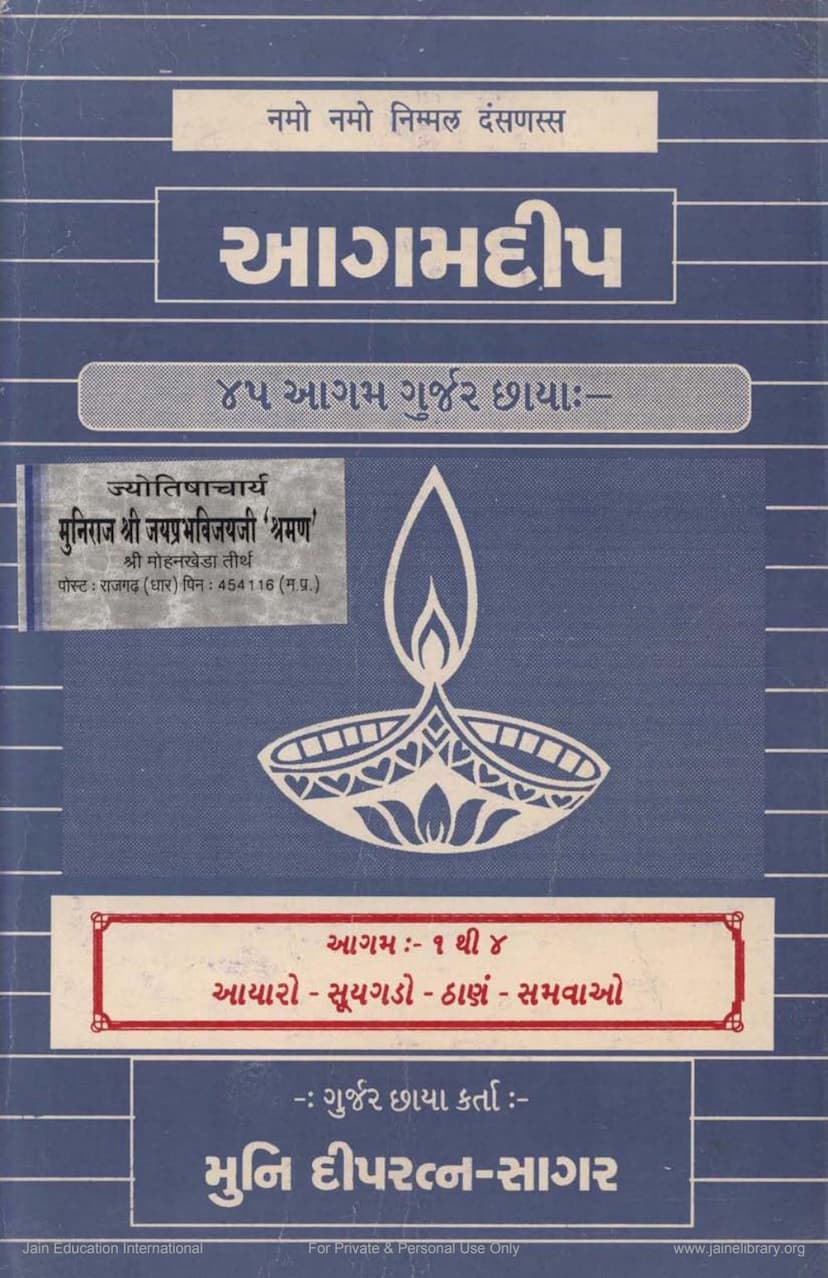Agam Deep 07 Uvasagdasao Gujarati Anuvaad
Added to library: September 1, 2025

Summary
This document is a Gujarati translation and commentary of the Jain Agam scripture Uvasagdasao (also known as Upasaka-dasa-sutra), which is the seventh Anga of the Jain canon. The title of the publication is Agam Deep 07 Uvasagdasao Gujarati Anuvaad, authored by Dipratnasagar and published by Agam Shrut Prakashan.
The core of the text is the Uvasagdasao, which details the lives and spiritual practices of ten prominent lay disciples (upasakas) of Lord Mahavira. The document provides a detailed Gujarati translation and explanation of these ten disciples' stories, focusing on their ethical conduct, vows, and spiritual progress.
Here's a breakdown of the content based on the provided pages:
-
Pages 1-3: These pages contain preliminary information, including invocations, publisher details, author credits, acknowledgments of financial supporters, and pricing information. The title "Agam Deep" and "Gurjar Chhaya" (Gujarati Commentary) are prominently featured.
-
Page 4: This page provides an index or table of contents for the Uvasagdasao, listing the ten main disciples (Anand, Kamdev, Chulni Pita, Suradev, Chillashatak, Kundolik, Sadalputra, Mahashatak, Nandini Pita, and Laiyapita) and the chapters (adhyayana) dedicated to each.
-
Pages 5-8: These pages list the financial contributors and sponsors of the publication, highlighting the importance of community support in bringing such religious texts to light. There's also a detailed list of other Jain Agam texts and publications by the publisher.
-
Pages 9-17 (and onwards): This is the main body of the translated text, detailing the lives of the ten lay disciples. Each disciple's story illustrates:
- Their worldly status and wealth: Describing their businesses, assets (like cows, wealth in various forms), and family life.
- Their encounter with Lord Mahavira: The initial meeting and the impact of his teachings.
- The adoption of lay discipleship: Taking the vows (anuvratas and shikshavratas) and the specific limitations they imposed on their worldly activities (like limiting possessions, certain types of food, etc.).
- The challenges and temptations faced: This is a significant theme, where divine beings or demonic forces (like Maya or Pisacha) would test their resolve by creating illusory scenarios or threats, often involving their families or possessions.
- Their steadfastness in faith: Despite these trials, the disciples remained firm in their spiritual commitment, demonstrating unwavering faith and courage.
- Their spiritual progress and eventual rebirth: The text often describes their eventual rebirth in heavenly realms (like Saudharma Devaloka) and their ultimate attainment of liberation (moksha) in the Mahavideh Kshetra.
-
Specific examples from the text:
- Anand: Faced temptations involving illusions of wealth and threats to his family. He demonstrated great detachment and ultimately attained Avadhi knowledge.
- Kamdev, Chulni Pita, Suradev, Chillashatak: These disciples faced severe tests from deities manifesting as terrifying beings (Pisacha, Elephant, Snake) who threatened them and their families with gruesome scenarios if they didn't renounce their vows. They remained resolute.
- Kundolik: Was tested by a deity who presented the teachings of Makkhali Gosala as superior, questioning Lord Mahavira's path. Kundolik's strong reasoning and adherence to Lord Mahavira's teachings led to the deity's silence.
- Sadalputra: Initially an adherent of the Ajivika sect, he was guided by a divine prophecy and Lord Mahavira's teachings to abandon his former beliefs and embrace Jainism. His wife, Agnimitra, also played a role in his spiritual journey.
- Mahashatak: His wife, Revati, driven by greed and worldly desires, plotted against his other wives and was ultimately warned by Mahashatak, using his Avadhi knowledge, of her future dire consequences (rebirth in a hellish realm).
- Nandini Pita and Laiyapita: These disciples also followed the path, with their stories emphasizing adherence to the lay vows and achieving a favorable rebirth.
-
Key Themes:
- The importance of Lay Discipleship: The text highlights the elevated status and spiritual potential of householders who sincerely follow the Jain path.
- The power of Vows (Vratas): The stories demonstrate how adherence to vows, even under extreme duress, leads to spiritual merit.
- Detachment and Non-attachment: The disciples' ability to remain unperturbed by threats to their wealth, family, or even life is a central lesson.
- The Role of Deities and Temptations: Jain scriptures often depict divine beings testing the faithful, and the Uvasagdasao illustrates this through the various trials faced by the disciples.
- The ultimate goal of Liberation: The narratives consistently point towards the eventual attainment of liberation as the highest achievement.
- The concept of Karma and Rebirth: The stories reinforce the Jain understanding of karma and its consequences, explaining the disciples' rebirths based on their actions.
In essence, Agam Deep 07 Uvasagdasao Gujarati Anuvaad is a comprehensive Gujarati rendition of a foundational Jain scripture, offering profound insights into the practice of Jain lay discipleship through compelling narratives of faith, perseverance, and spiritual triumph.